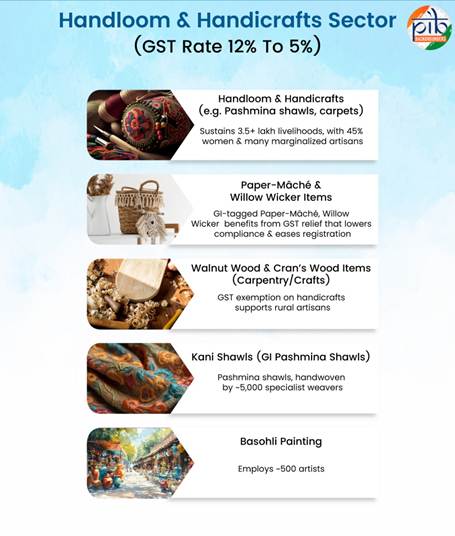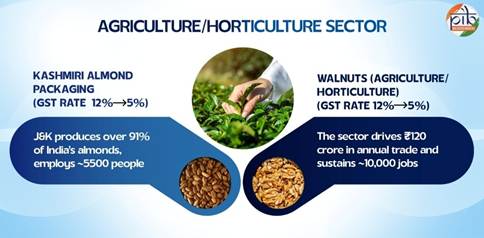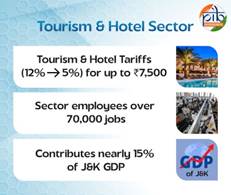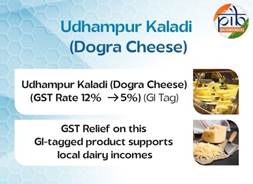PIB Headquarters
From Heritage to Growth: How GST Boosts J&K’s Economy
Posted On:
03 OCT 2025 6:43PM by PIB Delhi
Key Takeaways
- The GST cuts from 12% to 5% are poised to enhance the competitiveness of J&K’s handicrafts, agriculture, tourism, and specialty products.
- Heritage products, including GI-tagged Pashmina shawls, Dogra cheese, and Basohli paintings, are now better positioned to compete in domestic and global markets, preserving cultural identity.
- J&K contributes over 91% of India’s almond output, with its packaging industry benefiting from a GST cut from 12% to 5%.
|
Introduction
From the sun-scorched plains of Jammu to the snow-laden peaks of Kashmir, the winds of reform are sweeping across Jammu and Kashmir (J&K). The new GST changes arrive not as mere policy, but as a promise- lightening the tax burden on essentials, kindling demand, and opening doors to fresh opportunities for growth and employment in this rugged Himalayan expanse.
For India’s northernmost union territory, the timing could not be more opportune. These reforms cuts align seamlessly with J&K’s broader aspirations- industrial diversification, tourism promotion, and the upliftment of rural lives. Agriculture remains the heartbeat of the land, while the timeless artistry of handicrafts- wood carving, papier-mâché, carpets, shawls, and embroidery- continues to define its cultural and economic identity. Carpets alone bring precious foreign exchange to the valley.
Now, with lower GST rates breathing new life into these sectors, the promise is brighter: local crafts made more competitive, markets widened, exports strengthened, and livelihoods enriched. In every village and every marketplace, these reforms are poised to stitch together resilience and prosperity- ensuring that the spirit of J&K shines not only in its landscapes but also in its renewed economic journey.
Handloom & Handicrafts
Handicrafts have long been the soul of J&K’s economy- labour-intensive, rooted in tradition, and a wellspring of large-scale employment. From embroidery, shawls, papier-mâché, wood carving, and jewellery to silken carpets, these creations not only preserve cultural identity but also secure a strong foothold in international markets, earning valuable foreign exchange.
Complementing this is the handloom tradition, celebrated for weaving Pashmina, Raffal, silk sarees, and fine cotton fabrics. Both sectors, deeply embedded in the socio-economic fabric of the region, remain crucial for sustaining livelihoods, while strengthening J&K’s role as a global hub of heritage and artistry. The handloom and handicraft sector employs over 3.5 lakh direct and indirect people, including artisans and marginalized workers. Notably, women account for nearly 45% of these jobs.
With the reformed GST rates, the sector now carries only 5% GST, shunned down from 12%. This makes iconic products such as pashmina shawls and carpets, more affordable and competitive, both in domestic and international markets. By lowering costs, the entire Kashmir valley can gain from stimulated demand, boosted sales, and enhanced exports, directly benefiting artisans and weavers whose livelihoods depend on these crafts.

Paper-Mâché & Willow Wicker Items
Wicker willow handicraft is a J&K specialty, wherein wicker willow, a versatile and durable material, is woven by skilled artisans to create various products using traditional techniques. It benefits from GST relief, with rates reduced from 12% to 5%. This entails eased registration thresholds and lower compliance requirements for small traders. Similarly, paper-mâché, one of Kashmir’s most popular crafts and a GI-tagged traditional industry, welcomes the same revisions at a crucial time when it faces growing competition from machine-made substitutes. Key craft clusters such as Srinagar, Budgam, and Ganderbal stand to gain significantly from the GST rate reduction which boosts competitiveness, supports artisans’ livelihoods, and helps sustain these unique cultural industries.
Kani Shawls (GI Pashmina Shawls)
In the Kashmir Valley, especially Kanihama, nearly 5,000 weavers craft fine GI-tagged Pashmina shawls. The GST cut from 12% to 5% makes these shawls more affordable, boosting demand, exports, and competitiveness against machine-made imitations, while securing livelihoods and preserving Kashmir’s iconic heritage.
GI-tagged Basohli Painting, produced mainly in Basohli of Kathua district, employs nearly 500 local artists and is often described as “poems in colours.” With GST rates reduced from 12% to 5%, these paintings will become more affordable and marketable, encouraging wider demand and supporting the livelihood of artisans. The relief brings enhance competitiveness against cheaper replicas, strengthen cultural preservation, and open new avenues for promoting this unique art form in domestic and global markets.
Walnut Wood & Cran’s wood Items
Walnut wood and Cran’s wood crafts, integral to Kashmir’s carpentry tradition, have seen GST rates reduced from 12% to 5%. Predominant in districts like Budgam and Srinagar, the reform supports rural artisans by lowering costs, making products more affordable and competitive. Further, the reduction boosts sales in domestic markets, expands export potential, and increases tourist purchases, while ensuring better incomes for artisans. It also helps sustain traditional craftsmanship, safeguarding skills that form a vital part of Kashmir’s cultural and economic fabric.
Agriculture/Horticulture
Walnut cultivation across Anantnag, Kupwara, Kulgam, and Budgam of J&K plays a vital economic role- generating trade worth nearly ₹120 crore annually and providing employment to around 10,000 people. With the GST rate reduced from 12% to 5%, Kashmiri walnuts become more affordable and competitive in both domestic and international markets, encouraging higher demand and better prices for farmers. This not only strengthens rural livelihoods but also expands export potential, making the latest GST cut a fruitful step towards sustaining growth in one of J&K’s most valuable agricultural sectors.

Kashmiri Almond Packaging
J&K accounts for more than 91% of India’s almond production, with manufacturing and processing hubs concentrated across the Kashmir region. This sector alone provides employment to nearly 5,500 people, making it a crucial pillar of the local economy. The Kashmiri almond packaging industry particularly benefits from a significant GST reduction- from 12% down to just 5%.
This tax relief will not only lower production and packaging costs but also make Kashmiri almonds more price-competitive in domestic and export markets. The reduction may also help boost demand and sales volumes, encourage greater value addition within the state, and enhance profit margins for farmers and processors alike.
Tourism & Hotel Tariffs
 The natural beauty of J&K, from Jammu’s famous temples to the lakes and gardens of the Kashmir Valley, makes it a top tourist destination globally. The sector supports over 70,000 jobs and contributes nearly 15% of the state’s GDP. Tourist arrivals have risen steadily, from 2.1 crore in CY23 to 2.3 crore in CY24.
The natural beauty of J&K, from Jammu’s famous temples to the lakes and gardens of the Kashmir Valley, makes it a top tourist destination globally. The sector supports over 70,000 jobs and contributes nearly 15% of the state’s GDP. Tourist arrivals have risen steadily, from 2.1 crore in CY23 to 2.3 crore in CY24.
With GST on tourism and hotel tariffs reduced from 12% to 5% for stays up to ₹7,500, travel will become more affordable, boosting occupancy, encouraging longer stays, increasing revenue for local businesses, and further strengthening employment in the sector
Udhampur Kaladi (Dogra Cheese)
 Dogra cheese, a specialty from Udhampur district and a GI-tagged product, is renowned for its unique texture and flavor, making it a symbol of J&K’s rich culinary heritage. With the GST rate reduced from 12% to 5%, local dairy producers and small-scale cheese makers will benefit from lower production costs, improved profit margins, and enhanced competitiveness in both domestic and niche export markets. This tax relief encourages greater production, supports livelihoods, and strengthens the local dairy economy, ensuring that traditional products like Dogra cheese continue to thrive while sustaining rural employment.
Dogra cheese, a specialty from Udhampur district and a GI-tagged product, is renowned for its unique texture and flavor, making it a symbol of J&K’s rich culinary heritage. With the GST rate reduced from 12% to 5%, local dairy producers and small-scale cheese makers will benefit from lower production costs, improved profit margins, and enhanced competitiveness in both domestic and niche export markets. This tax relief encourages greater production, supports livelihoods, and strengthens the local dairy economy, ensuring that traditional products like Dogra cheese continue to thrive while sustaining rural employment.
Conclusion
The GST reductions in J&K, from 12% to 5% across handicrafts, agriculture, tourism, and local specialties are boosting competitiveness, lowering costs, and expanding markets. This relief strengthens artisan and farmer livelihoods, encourages exports, and drives employment, ensuring sustainable growth while preserving the region’s rich heritage.
References
dohh.jk.gov.in/
https://dohh.jk.gov.in/products-papier-machie.htm
india.gov.in
https://v2.india.gov.in/explore-india/odop/details/wicker-willow
industriescommerce.jk.gov.in
https://industriescommerce.jk.gov.in/hdd.html
IBEF
https://ibef.org/states/jammu-kashmir
indiawris.gov.in
https://indiawris.gov.in/wiki/doku.php?id=jammu_and_kashmir#:~:text=Agriculture%20is%20the%20mainstay%20of,of%20this%20state%20supports%20horticulture.
Click here to see in PDF
SK/M
(Release ID: 2174573)
Visitor Counter : 749